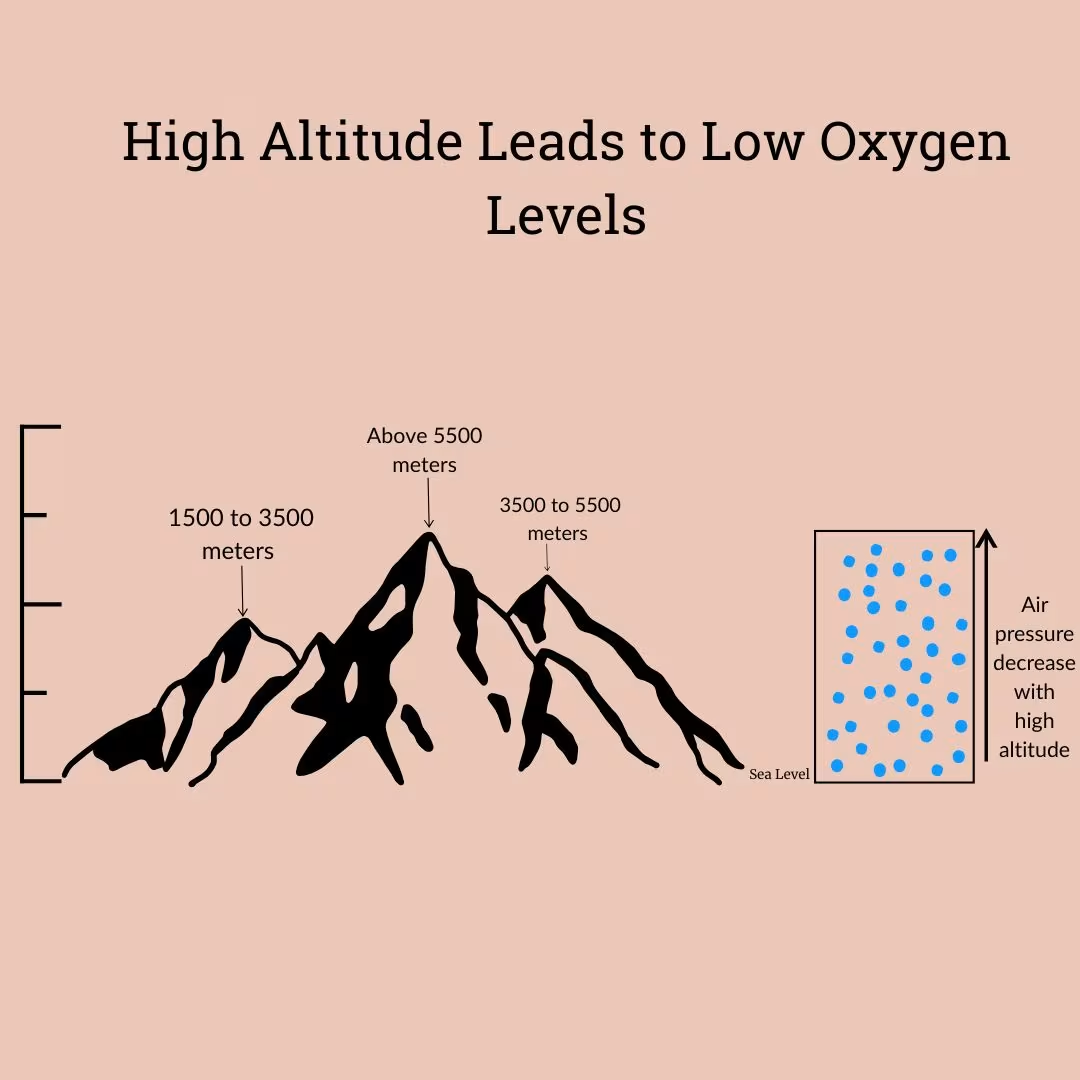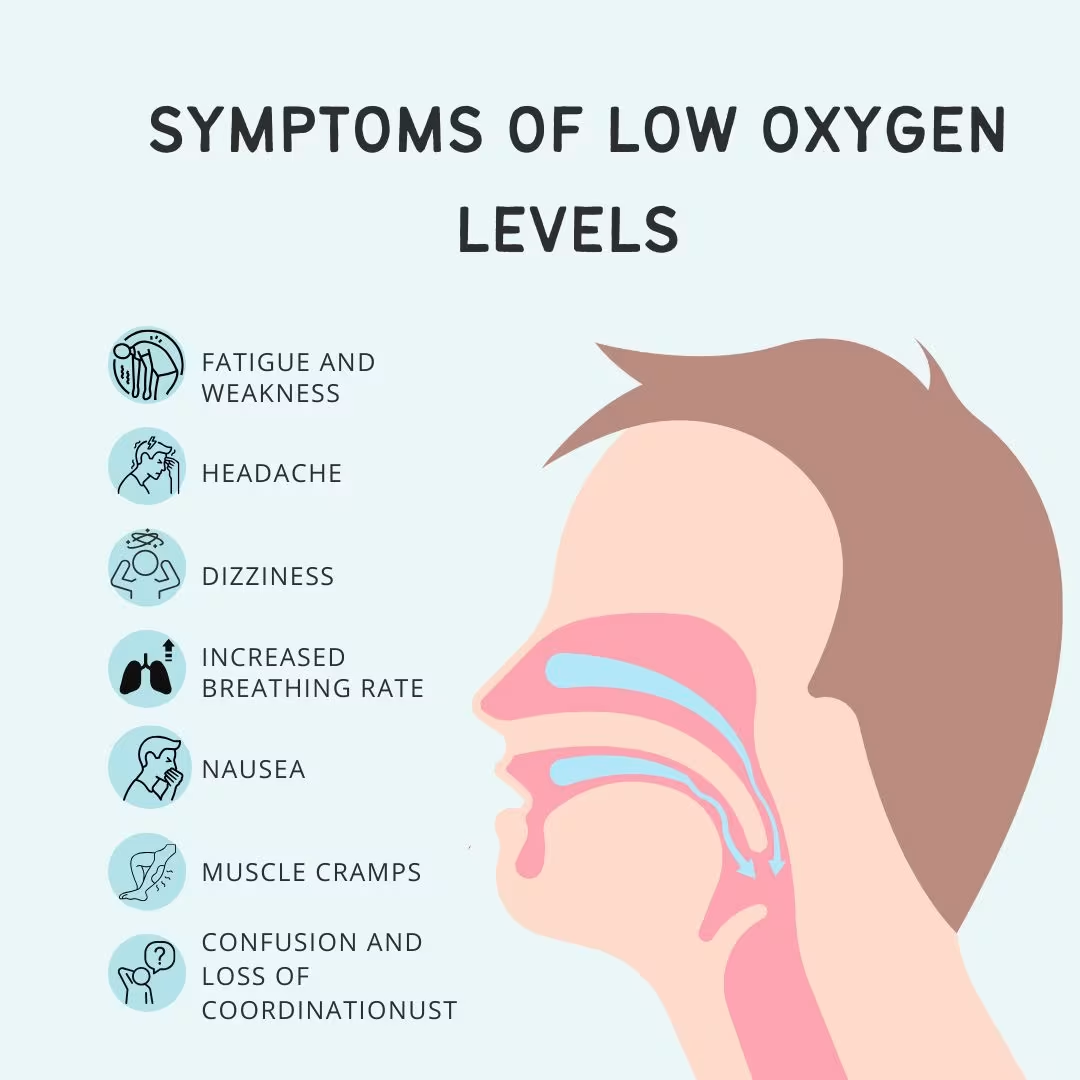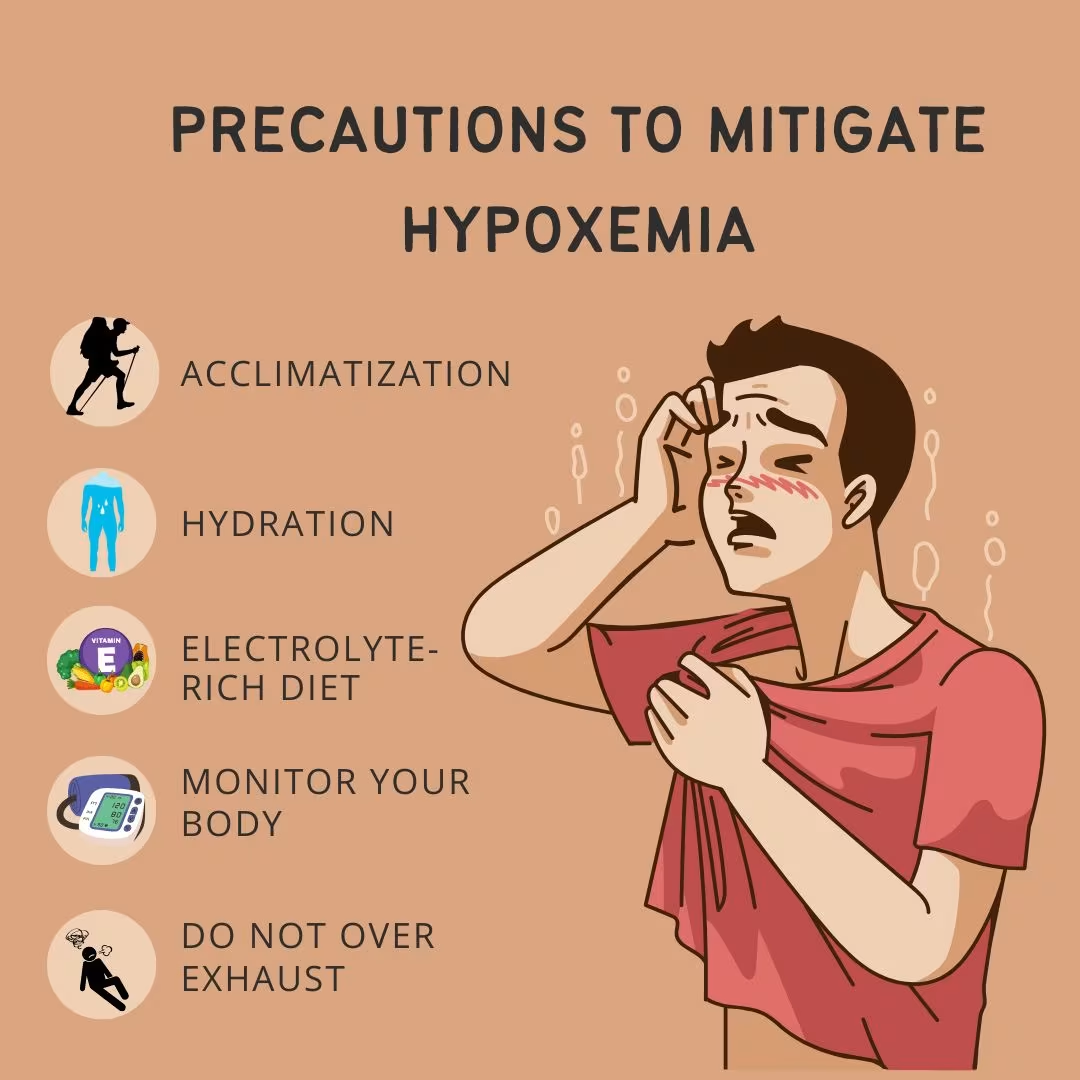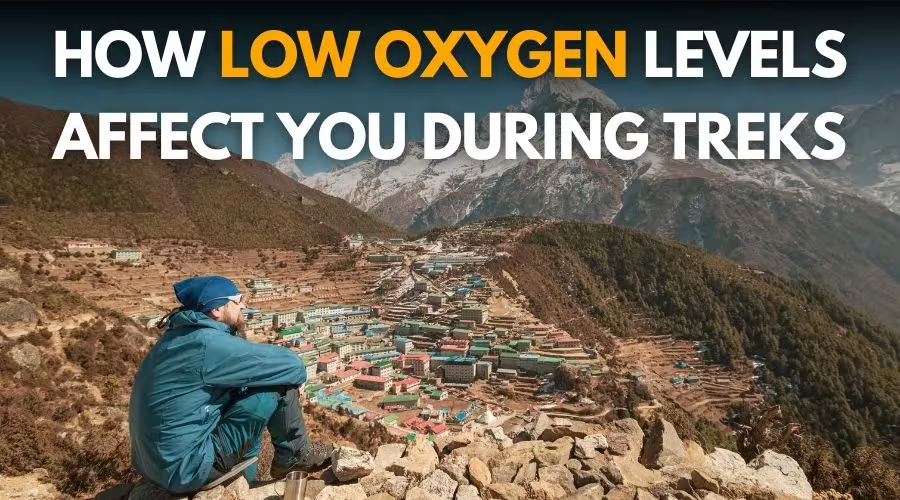Have you ever wondered why you feel more drained during high-altitude treks, even when you have a good physical calibre?
The underlying cause of this is the consequence of low oxygen levels on your metabolism and mental strength. Scientifically, we call this condition Hypoxemia, which can hit you during the trek expedition at high altitude.
It intensifies the risk of falling into the trap of High Altitude Illness or Acute Mountain Sickness (AMS). Furthermore, you can struggle with difficulty in breathing, dizziness, nausea, fatigue, confusion and headache as the symptoms of hypoxemia.
Henceforth, it becomes crucial to understand the impact of low oxygen levels for trekkers aiming to hike at high-altitude treks. Moreover, we shall throw light on the precautions to mitigate such difficulties caused by poor oxygen levels in high altitudes during the treks.
Stay tuned until the end, and you will get familiar with all the tips and tricks to overcome hypoxemia-related complications.
Table of Contents
What is Hypoxemia?
Hypoxemia is the condition of low oxygen level in your blood, causing tiredness, shallow breathing, wheezing, headache and mental confusion. Any internal or external condition that lessens the oxygen level in the blood can lead to Hypoxemia.
There are different reasons behind Hypoxemia in different situations, but here we are focusing on only high-altitude hypoxemia. Therefore, let us first understand the scientific mechanism behind this unfortunate condition.
How High Altitude Leads to Low Oxygen Levels

As documented by the Society of Mountain Medicine, the high altitude region ranges from 1500 to 3500 meters, very high altitude ranges from 3500 to 5500 meters, and extreme altitude ranges beyond 5500 meters. At all of these altitudes, you are more likely to face low oxygen level issues.
As the altitude above sea level rises, the atmospheric pressure falls, mainly resulting from the gravitational attraction between the planet and atmospheric gases. However some other factors like temperature and humidity variations also impact the atmospheric pressure at high altitudes.
Besides this, you can understand by the fact that there is less inherent atmospheric mass and air density at high altitudes, and it is directly proportional to atmospheric pressure.
For instance, when you are in a high-altitude region, there is less air above you compared to low-altitude regions.
One clarity about oxygen levels that you need to hear is that the fraction of oxygen in the atmosphere remains constant at all altitudes. What really goes down is the partial pressure of Oxygen. Let me tell you, the pressure difference, also known as partial pressure gradient, is the force which plays a vital role in the motion of atmospheric oxygen into the blood and, similarly CO₂ from the blood into the atmosphere.
Therefore, when atmospheric pressure goes down at high altitudes, then pressure gradient force also declines, which ultimately slows down the driving force responsible for gas exchange. As a consequence, the lungs inhale less oxygen, so the heart receives less oxygenated blood, and then overall body metabolism slows down, and this is how your oxygen level falls off during high-altitude treks.
Symptoms of low oxygen levels
Imagine, when you are on a trekking expedition at a high altitude, suddenly you feel symptoms of hypoxemia. But you are completely unaware of this condition and its symptoms. At that point, when you don’t know that these symptoms are due to poor oxygen levels, then how are you going to make genuine efforts to cure yourself?

In a nutshell, first, you need to know the disease, then only you can cure yourself at the high-altitude expedition, where medical facilities are far away. Therefore, now we are going to take a close look at symptoms of low oxygen levels in the body at high-altitude terrain.
Fatigue and Weakness:
The human body relies on Oxygen to maintain blood circulation, energy production and other metabolic functions.
Hence, when the oxygen level goes down, cells can not produce the required energy as well as body organs do not get enough oxygen to function normally. As a result, trekkers end up facing low energy levels, fatigue and weakness during the vigorous hiking adventure.
Headache:
Similar to other organs, when the brain receives less amount of oxygen, its normal functioning hinders and it causes a headache. Besides this, hypoxemia can cause dilation of blood vessels in the brain so that more oxygenated blood can inflow, but the dilation of vessels also causes headaches.
Dizziness:
Do you know what organ plays a key role in maintaining our body balance while walking and trekking? The organ that regulates our body balance and equilibrium is the inner ear. When it receives less oxygen, it can not function properly, and so trekkers often feel dizzy while trekking at high altitude treks.
Increased breathing rate:
When you are trekking on an uphill trail at a high altitude, the very first symptom that emerges is a fast breathing rate. The core reason behind this is that when your lungs and brain feel devoid of oxygen level, then they do hyperactivity by increasing breathing rate as an attempt to compensate for the void of Oxygen. Your body wants to intake more oxygen, so your breathing rate gets increases at high-altitude treks.
Nausea:
If you are facing hypoxemia during trekking at high altitude, then you are likely to suffer from nausea and vomiting. When the brain and stomach feel the lack of Oxygen, as a response, the chemoreceptors present in the brain get stimulated and cause nausea and stomach irritation.
Muscle Cramps:
When you trek at high altitude, the limbs remain active continuously. If your body lacks oxygen level, it disrupts electrolyte balance as well and this all causes muscle cramps and fatigue, especially in limbs. Besides this, during hypoxemia, muscles breath anaerobically, and it causes lactic acid accumulation, which also triggers muscle cramps.
Confusion and Loss of Coordination
Have you ever felt that suddenly you became confused and irritated during hiking at high altitude treks? This happens when you are struck by hypoxemia. The low oxygen levels affect your brain functioning, cause cerebral hypoxemia and disturb neurotransmitter balance. Neurotransmitters are the hormones, which are known to uplift your mood and mental sharpness. Hence, you feel confused and mentally stressed due to low oxygen levels.
Precautions to mitigate Hypoxemia
We have discussed the symptoms of hypoxemia in detail, and now we move forward and explore the precautions to avoid low oxygen levels during the trekking adventure at higher altitudes.

Acclimatization
In the words of a mountaineering legend, Reinhold Messner, acclimatization is not just about the body’s physical response to high-altitude terrain but also about the mind’s ability to adapt and overcome.
Acclimatization is a process of physiological and circulatory adaptation to the high-altitude region where atmospheric pressure and temperature are quite low. In response to this, our body undergoes erythropoiesis, which catalyzes the formation of red blood cells. With the increase of red blood cells, the oxygen-carrying capacity also goes up, and this is how our body copes with hypoxemia.
Let us have a look at the ways to acclimatize properly.
- First of all trekkers should ascend to higher altitudes gradually so that the body can acclimatize properly.
- Along with this, it’s recommended to plan rest days during trek expeditions, maintain a hydration level, and have an electrolyte-rich diet.
- If you follow these steps sincerely, then your body will easily adapt to the high-altitude terrain.
Maintain your hydration level
Hydration is necessary to smooth the functioning of oxygen transport and our metabolism. A good hydration level decreases the blood viscosity, increases the red blood cells’ flexibility and ensures the high delivery of oxygen to the body.
If you intake an adequate amount of water regularly on your high altitude trek, it can help you beat low oxygen level complications.
Electrolyte-rich Diet
The electrolytes like sodium, potassium, magnesium and calcium have a crucial role in maintaining oxygen levels, blood pressure, red blood cells, fluid balance and energy production in our body. Therefore, if you consume an electrolyte-rich diet, it contributes to enhancing oxygen transport and reduces the incidents of hypoxemia.
Monitor your body
Understanding your illness is the first step towards beating it.
However, we generally underestimate the importance of monitoring our body at regular intervals during high-altitude trekking. And this way, we often ignore the warning signals given by our body, which can lead to serious repercussions.
Hence, It’s crucial to listen to the voices and intuitions of our body. When oxygen level declines inside us, our body gives multiple signals to make us realise the imbalance ongoing inside. So, if trekkers are aware enough to catch the hypoxemia symptoms, then it can be cured as well.
Do not over-exhaust
Over-exhaustion during the high-altitude trek is the biggest mistake that you can commit. If you are a trekker and want to climb at challenging summits, then you need to understand that high-altitude trekking demands dedication like a marathon, not a sprint. If you push yourself harder to climb the summit in less time, then you are at high risk of altitude sickness. Hence, the trekkers shouldn’t over-exhaust themselves and should pay attention to acclimatization.
High-altitude Hacks: Tips for countering low oxygen level
Here are a few tips that can help you in high-altitude oxygenation.
First aid for trekkers
In remote areas of high altitude, you can not find immediate medical facilities. Therefore, it’s essential to carry a first aid kit containing all the necessary medicines for altitude sickness and Hypoxemia.
Stay weather aware
You should check the weather forecast before going on a high-altitude expedition. If there is a warning of low atmospheric pressure, then you should pay heed to it because low atmospheric pressure can lead to situations like hypoxemia and altitude illness.
Plan treks with a guide
Trek guides have a deep understanding of the trek route, local terrain, weather patterns, tackling the emergency, and ensuring safety. Therefore you should consider going on high-altitude treks with the assistance of an expert trek guide.
Be Aware
The best mode to avoid hypoxemia at high-altitude treks is to be aware of your body’s response. Whenever you feel symptoms of low oxygen level, it’s recommended to take a break, drink water, and seek the help of your trek guide.
Get your VO2 max test done
VO2 max is the maximum rate by which you can consume oxygen to produce energy during vigorous exercise like high-altitude trekking. It is also known as an aerobic capacity and cardiorespiratory fitness test and is considered accurate for measuring the physical fitness of an individual on the basis of gender, age and weight. You can get your VO2 max test done to understand the endurance of your body.
However, if you have a low VO2 max, that doesn’t mean you can not perform well in high-altitude hiking. Because there are some other factors like lactate threshold level, altitude tolerance level, and mental strength also decide your trekking performance at higher altitudes.
Carry pulse oximeter
A pulse oximeter is an easy-to-carry tool which monitors the oxygen saturation level within seconds. If it shows a low oxygen saturation level, you might be at risk of acute mountain sickness. Therefore if you are planning an adventure to high altitude, the pulse oximeter can be your companion on the trek.
Carry an oxygen portable cylinder
An oxygen portable cylinder is an emergency game changer for trekkers at high altitudes. It is a small portable cylinder containing about 10 to 12 litres of oxygen. Unfortunately, if you struggle with low oxygen levels during high-altitude trekking, then you can inhale oxygen pumps through this useful oxygen gear to get instant relief.
Wrapping Up
As Sir Edmund Hillary says, It’s not the mountain we conquer but ourselves.
In the same manner, when you go for a trek at a high altitude and struggle with demoralizing symptoms of low oxygen level, then you realise your sensitivity and discover your endurance. We intend to say that coping with high-altitude challenges like hypoxemia is not only physical, but it’s mental too. Hence, you need to put in physical as well as mental efforts to overcome the poor oxygen level condition at high-altitude treks.
Besides this, we have explained hypoxemia and its symptoms in detail to make you aware of this high-altitude obstacle. Furthermore, we have shared preventive measures and hacks that can help you in combating low oxygen levels.
So now, when are you planning a high-altitude trek with full preparation for overcoming low oxygen levels?
References
- https://www.ncbi.nlm.nih.gov/books/NBK539701/
- https://www.npl.co.uk/resources/q-a/atmospheric-altitude-pressure-changes
- https://en.m.wikipedia.org/wiki/Atmospheric_pressure
- https://www.britannica.com/science/acclimatization
- https://www.physio-pedia.com/Acclimatisation
- https://pubmed.ncbi.nlm.nih.gov/8157369/
- https://pmc.ncbi.nlm.nih.gov/articles/PMC2384143/
- https://my.clevelandclinic.org/health/diseases/17727-hypoxemia
- https://iantaylortrekking.com/blog/how-do-you-train-for-high-altitude-and-low-oxygen-environments/
- https://www.physio-pedia.com/VO2_Max
- https://www.physio-pedia.com/Lactate_Threshold
- https://pmc.ncbi.nlm.nih.gov/articles/PMC4273179/

Leave a Comment